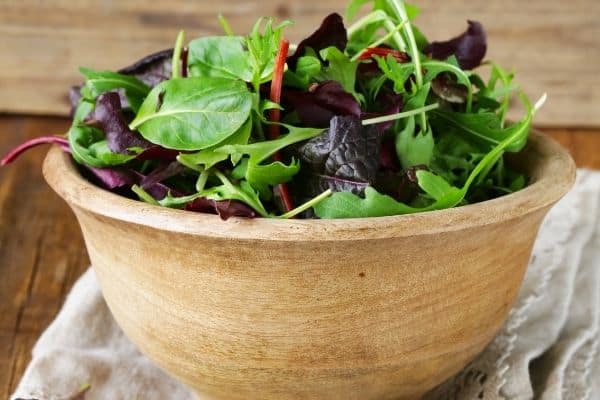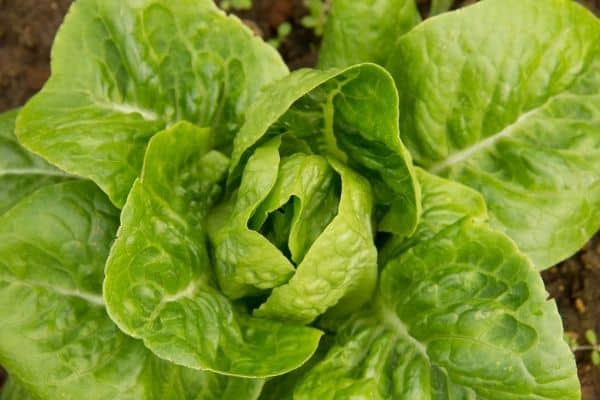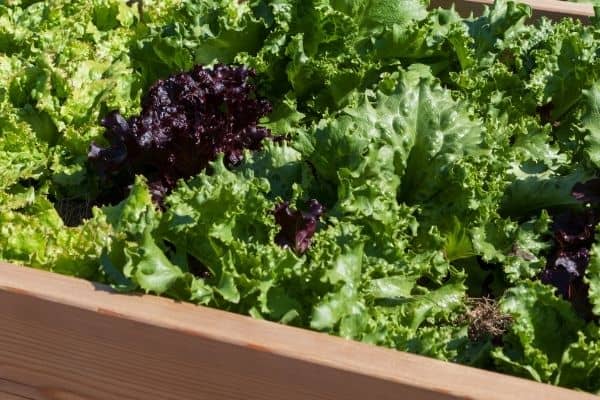It is great to grow your own food, harvest that food, and then in some form or another preserve that food to make it available year-round. What is even better though is having something fresh from the garden you can eat year-round.
Listen To The Podcast
Listen and Subscribe On Your Favorite Podcast Player
Spotify | Apple Podcasts | Amazon Music | Pandora | Pocket Casts | Castbox | Anchor | YouTube | RSS | Get Ad-Free On Patreon

While it’s possible to grow most things indoors and have them fresh all year, the cost of doing so can be pretty high as setting up indoor growing rooms with climate control and grow lights can be expensive.
I have found that for me most things are best to grow seasonally and then preserve the harvest but there is one thing I like to have available year-round to eat fresh, and that is lettuce. It’s easy to grow as it doesn’t have as many needs as many other plants and there is something special about making a salad from fresh lettuce in January in Indiana.

I have mentioned a few times on the podcast that I do this but I guess I have never gone into much detail about how I do it. This sparked a question in The Homestead Front Porch Facebook Group that I said I would answer on the podcast.
Ronnie Asks: You mentioned in a podcast that you grow salad year round. Would you care to go in depth on your process or maybe if you were going to start from scratch? I’d love more details, I have a sunroom that I could set up 3 or 4 tables in and keep it semi climate controlled.
I do this differently now than I did in the beginning so I will talk about a few ways to do this. Most people I think assume growing lettuce in the wintertime is the biggest challenge but for me, it has been growing it in the heat of summer. So I will talk about that first.
Growing Lettuce In The Heat Of Summer
Create Microclimates
Lettuce doesn’t like hot weather and while there are more heat-tolerant varieties than others, lettuce still needs the coolest climate you can provide for it in the heat of summer to thrive. Many gardeners have experienced planting lettuce, getting excited as it quickly sprouts and begins to form those delicious leaves only to see it bolt and turn bitter as it goes to seed before you can harvest anything.
In my yard, I have created the perfect spot for growing lettuce in the heat of summer. This location only gets about 3 hours of direct full sun in the late morning and about 3 hours of dappled sunlight afterward in mid-summer. This keeps the area several degrees cooler than other parts of my yard by providing the minimum amount of sunlight lettuce needs to thrive and completely blocking the hot late afternoon sun I am able to have lettuce that provides for me for a reasonable amount of time before it bolts.
Succession Planting
Even in the microclimate I have, the lettuce will bolt quicker in Summer than it does in Spring or Fall so to keep a constant rotation of good edible lettuce I practice succession planting. About every 2 to 3 weeks in summer I plant another row of lettuce seeds and keep five, eight-foot rows going at a time so as one row starts to bolt another is just reaching its peak of goodness.
Plant Heat Tolerant Varieties
My favorite lettuce is Romaine and the variety that does best in the heat is called Parris Island Cos. I find this lettuce can actually handle quite a bit of sunlight and heat and it grows a little slower in my special microclimate area.
Another variety I enjoy is a common Bibb variety called Buttercrunch. Most gardeners who grow lettuce are familiar with this lettuce and its great taste and I find it is one of the best year-round varieties you can grow.

The one I grow the most of though is probably my least favorite tasting of the three and that is a Leaf Lettuce variety called Black Seeded Simpson. The question will surely arise that if it’s my least favorite of the three why do I grow the most of it? Because it’s the easiest, quickest, and most climate tolerant of the three and it’s a sacrifice I’m willing to make. It’s actually not much of a sacrifice, I like it just fine, I just think the other two are a little better texture and more flavorful.
Harvest In The Early Morning In Summer
It will make all the difference in the world if you harvest your lettuce in the morning in the Summertime as this will provide you with the best taste, texture, and preservation factor of your harvested lettuce. Lettuce leaves will quickly dry out and the stems get sappy as they heat up so picking your lettuce early in the morning will provide you with leaves that are at their most crisp, cool, and bursting with moisture.
Growing Lettuce In The Winter
This is where my methods have changed. I used to grow my lettuce in the house under grow lights in the winter but now I grow it in my greenhouse. Both methods have their struggles but both work so I will go over these two methods and let you decide which works best for you.
How To Set Up Indoor Grow Beds With Grow Lights
Building the beds.
Lettuce doesn’t require deep soil for its roots so I’ve found that 2×4’s work really well for the sides of the beds allowing you just under 4 inches of soil depth.

–
Choosing soil
This is pretty important. You don’t want to bring soil in from your garden to plant indoors as you will probably invite a serious aphid problem into your indoor grow beds. The climate and protection you are providing create a perfect environment for aphids to flourish.
You will want to use decent quality potting soil as this will provide your lettuce with the nutrients you need and not have the issues of using your garden soil.
Temperature control
Lettuce will grow okay in temperatures between 60 and 80 degrees but I find it does better on the lower end of that spectrum. Keeping your soil temps around 65 degrees will give you the most successful indoor lettuce growing beds.
Lighting options
If you want to use fluorescent bulbs for your indoor grow beds listen to this episode – What Lights Should I Use For My Indoor Garden?
However, when I did that podcast episode a few years ago LED grow lights were still really expensive and I didn’t think they were the best option at the time. Since then these lights have become much more affordable and are extremely efficient and better in nearly every way.
The LED lights I now use when I need to grow indoors are the Barrina LED Grow Lights. I have been using these lights in my indoor aquaponics setup for several months and they work great and are affordable and use a relatively low amount of electricity for the light they give.

- Full Spectrum – Barrina LED grow lights provides sufficient light for indoor…
- Updated Plant Light Chips- Compare with the lamp consisting of only “blue chips”…
- Reflector Design and Low Consumption – Consume only 144W with 576 LEDs totally,…
Last update on 2024-07-26 / Affiliate links / Images from Amazon Product Advertising API
Growing In A Greenhouse In The Winter
Full Sun
In the winter the days are obviously much shorter so you will have to provide your plants with the maximum amount of direct sunlight they can get to grow well. This is where I think many growers fail in the winter as they think using a sunroom or a south-facing window will be enough light but in reality, the sun isn’t directly shining on the plants the entire day. This will cause your plants to grow “leggy” having long stems and not much leaf production.
Choosing Soil
This is the same as indoor growing. You will need to use a good potting soil mix to minimize pests, specifically aphids.
Temperature Control
Again this is the same as growing in your house only a little more challenging as greenhouses will fluctuate in temperatures much quicker than your house.
To keep your soil around the ideal growing temps you will need to heat the greenhouse and/or the soil, especially at night. My greenhouse isn’t very large (6’x8′) so I’m able to heat it with a temperature-controlled electric heater and electric seedling heat mats under the beds. This, of course, does add to the electric bill but for me, it’s worth it for the fresh homegrown salads through the winter.
–
A Couple Of Final Recommendations
When it comes to growing food year-round there are some true experts out there. I would like to recommend a book called Four-Season Harvest: Organic Vegetables from Your Home Garden All Year Long, 2nd Edition by Eliot Coleman.
Also, I would like to recommend a very useful tool if you are going to be harvesting a lot of lettuce. Washing lettuce is easy compared to many vegetables but if you want to get it dried off quickly so you can enjoy it fresh and right away you need a good salad spinner. This is the one I own and we love it, Cuisinart 5-Quart Salad Spinner.
- QUICK & CONVENIENT: Wash and spin-dry salad greens, fruits, and vegetables...
- USER FRIENDLY: Easy-to-use spin knob allows for quick and efficient spinning...
- STABILITY: Non-skid base keeps the bowl stable and prevents any unwanted...
Last update on 2024-07-26 / Affiliate links / Images from Amazon Product Advertising API





